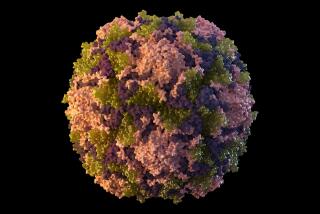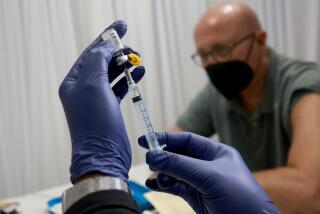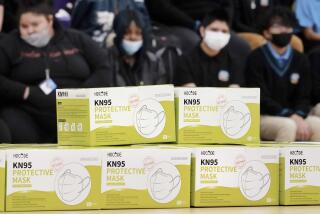Study Shows Younger Women in N.Y. City Have 1-in-77 AIDS Virus Infection Rate
- Share via
One in every 77 women of childbearing age in New York City is infected with the virus that causes AIDS, according to a new study that officials say offers one of the first accurate pictures of how the disease is spreading in the population at large.
The survey of infection in infants born in New York state, one of the first in a series being conducted by 44 states and territories, also found that one in every 151 women of childbearing age statewide is infected with the human immunodeficiency virus (HIV).
“I would certainly think the word ‘alarming’ would be an apt descriptor,” said Dr. Lloyd F. Novick, the New York state health official who headed the study. “. . . A key aspect to follow is (whether) this rate of infection will decrease or increase over time.”
Published in Journal
The survey results, published today in the Journal of the American Medical Assn., are among the first to be published in the nationwide series. The studies may eventually offer the only truly representative estimate of the extent and direction of the virus’ spread.
Preliminary results from a similar California study indicate the infection rate among childbearing women is much lower here than in New York, offering what public health officials say is a valuable opportunity to slow the spread of AIDS in that crucial group.
“It helps the health department know where there’s a problem, what it is, is it changing over time,” said Dr. Timothy J. Dondero of the U.S. Centers for Disease Control. “It doesn’t answer all the questions, but at least it tells them where they need to focus.”
The New York study--intended to measure the infection rate among childbearing women, monitor trends and help pinpoint AIDS education and prevention efforts--was based on blood samples required by law to be taken from every baby born in the state.
Samples Taken Over Year
Samples were taken from 276,609 newborns between Nov. 30, 1987, and Nov. 30, 1988. Antibodies to the AIDS virus were detected in 0.66% or 1,816 newborns statewide. The rate in New York City was 1.25%. Blacks and Latinos were the hardest hit.
Not all of those newborns will turn out to be infected, the researchers noted. They estimated that about 40% were actually infected, while the remainder will prove to be uninfected but temporarily carrying their infected mother’s antibodies.
Even so, Novick noted that the estimate of 726 infected babies in a single year contrasts sharply with the number of pediatric AIDS cases reported in the state. Only 117 cases were reported in 1987; the cumulative total through 1988 was only 422.
“That’s very different from the type of estimate one gets from looking at the reported cases of AIDS in New York,” Novick said of his findings. “. . . It’s likely that there are many more children (infected or with AIDS) in the community than what we know about.”
Directs Health Center
Novick is the director of the state’s Center for Community Health.
In California, a similar study by the state Department of Health Services found the rate of infection among newborns to be 0.083%--compared to 0.66% in the New York study. Los Angeles County officials put the rate among childbearing women in the county at 0.042%.
The only other published results from the studies throughout the nation came from Massachusetts, where the rate was 0.21%. Alluding to preliminary findings from other states, Dondero called the New York numbers “the highest of the states we’re aware of at this time.”
Novick’s study did not explore how the mothers had become infected. But the geographical patterns of infection correlated with areas of high drug use. The areas with high infection rates were the same communities that have high rates of drug-related hospital discharges.
Previous Findings
That observation is consistent with previous findings that intravenous drug use and sex with infected partners are the leading causes of HIV infection among New York women (although the overall HIV infection rate among drug users in New York City and San Francisco appears to be leveling off). The virus is transmitted sexually and through the exchange of blood--for example, in shared needles.
Experts say surveys like the one in New York may end up providing the only truly representative picture of the epidemic’s spread. Most other studies of the extent of infection focus on more narrowly defined groups and are less representative of the general public.
More to Read
Sign up for Essential California
The most important California stories and recommendations in your inbox every morning.
You may occasionally receive promotional content from the Los Angeles Times.













